Green Gardening | Best Practices that Are Good for the Earth and Your Yard
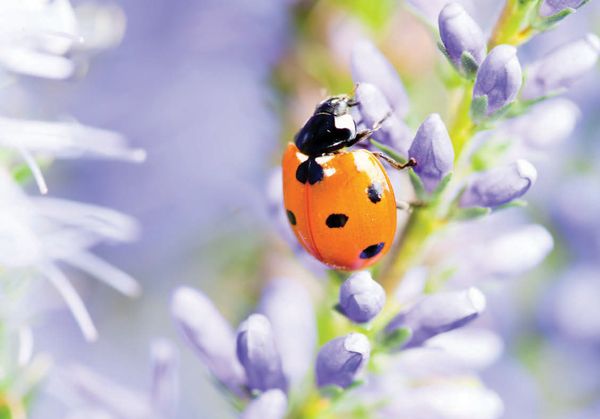
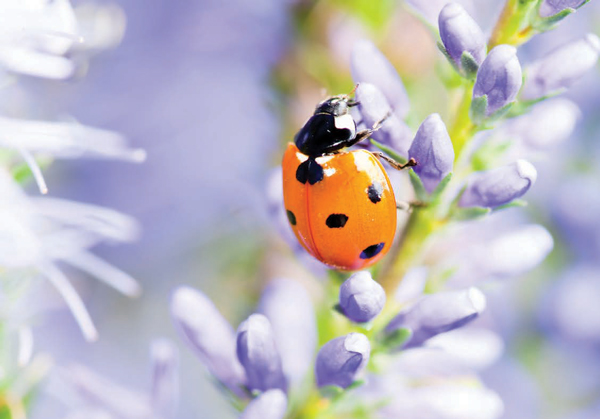
There are many reasons why making your garden more eco-friendly is a good idea: It reduces your impact on the earth, it helps attract pollinators, it’s better for your garden … but perhaps the best argument is that it’s so easy. Here are a few ways to care for your garden—and the environment—this summer.
Happy dirt
Happy dirt is home to all sorts of hidden biospheres that make for healthy plants. Synthetic fertilizers require fossil fuels in their production while their runoff has detrimental effects on local bodies of water. Instead of chemical fertilizers that have a bigger environmental footprint, use organic materials as fertilizer such as compost or other organic fertilizers, like compost tea (made from soaking a small amount of compost in water for a few hours) or a natural fertilizer made of fish or seaweed. Compost is easily made with kitchen scraps, leaves, sawdust and other natural materials mixed together in a container and allowed to decompose naturally. There are a wide variety of compost bins available; whether you choose to follow a DIY tutorial on the internet or purchase a ready-made backyard tumbler, it’s easy to get going on your own compost bin. Turn it regularly and keep it watered to help turn these items from waste into a helpful garden additive that is sometimes referred to by gardeners as “black gold.”
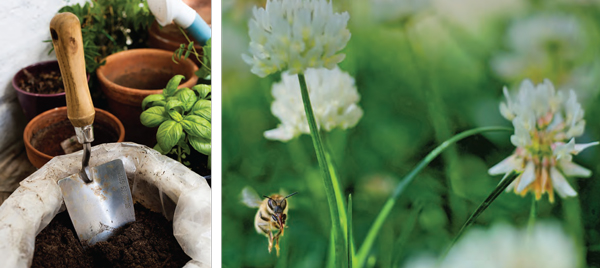
IF YOU THINK ABOUT IT, ECO-FRIENDLY GARDENING IS REALLY JUST A RETURN TO HOW OUR GRANDPARENTS GARDENED, RELYING ON NATURAL METHODS THAT WITHSTAND THE TEST OF TIME. IT’S GENTLER ON THE EARTH, BUT MANY OF THESE METHODS ARE ALSO GENTLER ON OUR POCKETBOOKS AS WELL.
Perfectly imperfect lawns
Lawns can be one of the most problematic parts of an eco-friendly yard. To maintain a perfectly lush, green lawn can require fertilizers, pesticides and water. To make your lawn more environmentally friendly, perhaps you can learn to live with a few dandelions and other imperfections. Dandelions are actually a great food source for pollinators in early spring and can be edible for humans as well. Their greens have a sharp bite to them, similar to arugula, and make a very tasty salad green, or can be cooked into a dish or turned into pesto. Lawns that have slightly longer grass tend to do better during those hot, dry spells that come in late summer, so raise the blade on your mower up a notch, and consider mowing less frequently. Your lawn will be happier for it. Instead of raking or blowing leaves in the fall, run the mower over them, mulching them back into the lawn and creating a free fertilizer as they spend the winter breaking down into the soil.
Rain barrels
To help reduce water usage, consider installing a few rain barrels around your property. Some localities offer rebates for installing rain barrels for helping to decrease dependence on area water systems in droughts. Rain barrels connect to downspouts, collecting rainfall as it comes off your roof. The water, while not potable, can be used to water plants and do other chores, like washing your vehicle. If storm runoff is an issue in an area around your home, rain barrels are an effective tool at helping to combat the erosion and other problems that can arise from storm water issues.
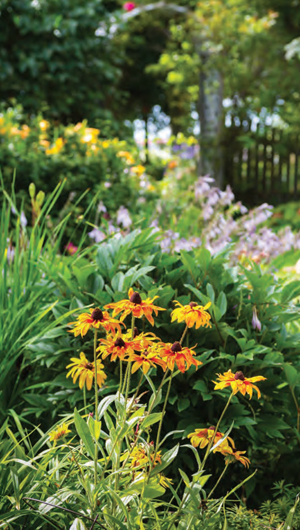 Smart planting
Smart planting
Planting native plants can also help with reducing your water usage. Native plants are adapted to our growing conditions and once they are established, can thrive with little effort on your part. When planting anything in your yard, take the conditions where the plant will go into consideration. If a plant does better in part shade, don’t plant it in full sun, and vice versa. This will go a long way in creating a happy, lush garden.
Another helpful characteristic of planting native plants in your garden is that they help attract pollinators, including birds, to your yard, creating a thriving eco-system. Birds can help act as pest control, as they will feast on bugs they find, including slugs, grubs and caterpillars that want to make themselves at home in your garden. Avoid using pesticides, as they don’t discriminate in what bugs they take out, often having a detrimental effect on the good insects, like bees and butterflies. There are several natural options to take before reaching for a chemical solution that could have a bigger effect than you anticipate.
To avoid mosquitos, don’t leave standing water around for their larvae to grow. Birds aren’t the only natural pest control you can employ, as attracting the right bugs to your garden via plantings goes a long way in dealing with the bugs you don’t want. Incorporate plants that attract the bugs you want. For example, sunflowers, marigolds and nasturtiums are among the plants that draw ladybugs, a very beneficial bug, to the yard. Some gardeners will hand pick bugs off a plant, but for heavier infestations, there are easier options. Natural pesticides can be made with common household items to be sprayed on plants, such as dish soap, oil, and sometimes cayenne pepper, depending on the plant and pest. They may have to be reapplied after a rain, but they can go a long way in battling pests like aphids or squash bugs.
Companion planting is another effective tool in the fight against pests. The basic idea behind companion planting is that plants do well when planted with friends. For instance, planting basil near tomatoes or dill near your cucumbers helps deter pests that may otherwise consider making a meal out of your tasty vegetable plants.
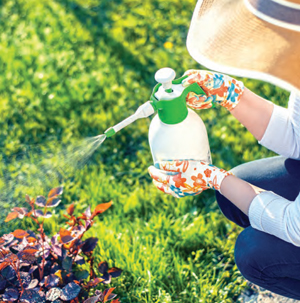 Weed control
Weed control
To help with the inevitable weeds, mulch can go a long way toward reducing their number while also helping the ground hold onto moisture longer. There are a number of options available, from wood chips to shredded leaves, that can help create neat beds. Some vegetable gardeners use layers of cardboard or newspaper between plants to help keep weeds to a minimum. If you must spray something to help in your battle with weeds, consider a homemade solution instead of reaching for a chemical solution. Vinegar combined with salt or borax and dish soap is known to be an effective weed killer that’s easily made with items found in our homes.
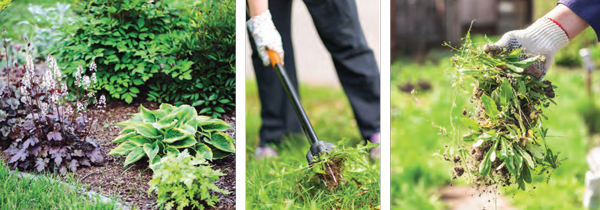
If you think about it, eco-friendly gardening is really just a return to how our grandparents gardened, relying on natural methods that withstand the test of time. It’s gentler on the earth, but many of these methods are also gentler on our pocketbooks as well. And that is something I think we can all agree is always an excellent argument. ✦
biospheres, Birds, Companion Planting, compost, Dandelions, environmentally friendly, garden, grubs, native plants, organic fertilizers, pest control, pollinators, rain barrels, slugs, Weed control






